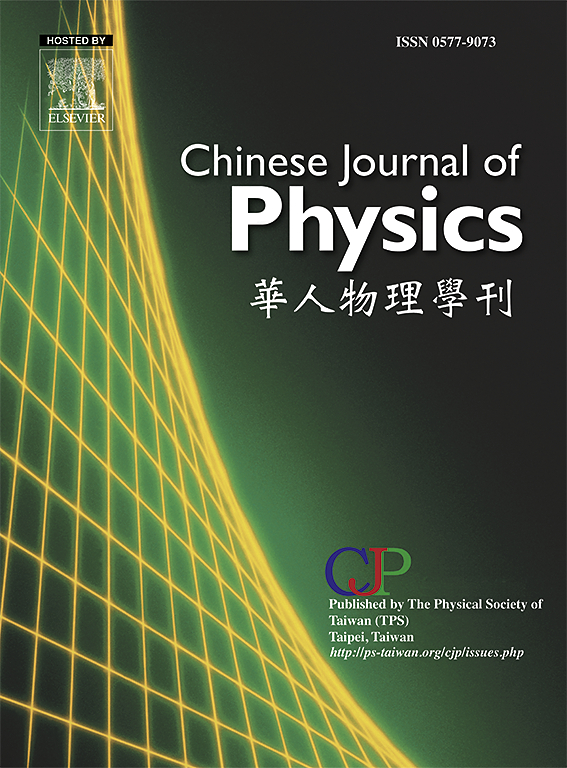二维 TaGe2P4-WSi2As4 范德华异质结:近乎理想的整流器
IF 4.6
2区 物理与天体物理
Q1 PHYSICS, MULTIDISCIPLINARY
引用次数: 0
摘要
寻找合适的二维金属-半导体界面来设计高性能肖特基二极管对于器件的不断微型化至关重要。在此,我们通过第一原理计算,提出了一种近乎理想的二维范德华整流器,它由单层 TaGe2P4 金属和 WSi2As4 半导体组成,具有超洁净界面和自由悬键。范德华异质结在垂直和横向界面上都有一个 p 型肖特基接触。肖特基势垒导致正负偏置电压下的电子传输不对称,从而产生了显著的整流特性。通过调节半导体和重叠区的长度可以改善整流特性,在低偏置电压下可以获得 107 的超高整流比。整流效应的起源和调节机制从投影局部态密度、透射特征态、电位降和透射光谱等方面进行了解释。研究发现,增加器件中半导体部分的相对长度会增大肖特基势垒的宽度,这在很大程度上降低了由电子隧穿主导的反向电流,而对正向电流影响不大,从而显著改善了整流性能。这些结果表明,TaGe2P4-WSi2As4 范德华异质结作为一种接近理想的整流器具有广阔的应用前景。本文章由计算机程序翻译,如有差异,请以英文原文为准。
A two-dimensional TaGe2P4–WSi2As4 van der Waals heterojunction: A near-ideal rectifier
Searching for suitable 2D metal-semiconductor interfaces to design high-performance Schottky diodes is essential for the continuous miniaturization of devices. Herein, by using the first-principles calculations, we propose a near-ideal two-dimensional van der Waals rectifier consisting of the monolayer TaGe2P4 metal and the WSi2As4 semiconductor with ultra-clean interface and free dangling bonds. The van der Waals heterojunction has a p-type Schottky contact at both the vertical and lateral interfaces. The Schottky barriers lead to the asymmetry of electronic transport under the positive and negative bias voltages, thus resulting in a remarkable rectification behavior. The rectifying properties can be improved by regulating the length of the semiconductor and the overlapping region, and an ultra-high rectification ratio of 107 is obtained at a low bias voltage. The origin of the rectification effect and the regulating mechanism are explained in terms of the projected local density of states, transmission eigenstates, potential drop, and transmission spectra. It is found that increasing the relative length of the semiconductive part in the device enlarges the width of the Schottky barrier, which largely reduces the reverse current dominated by the electron tunneling while little affects the positive current, and thus leads to a significant improvement in the rectification performance. These results suggest that the TaGe2P4–WSi2As4 van der Waals heterojunction has promising application as a near-ideal rectifier.
求助全文
通过发布文献求助,成功后即可免费获取论文全文。
去求助
来源期刊

Chinese Journal of Physics
物理-物理:综合
CiteScore
8.50
自引率
10.00%
发文量
361
审稿时长
44 days
期刊介绍:
The Chinese Journal of Physics publishes important advances in various branches in physics, including statistical and biophysical physics, condensed matter physics, atomic/molecular physics, optics, particle physics and nuclear physics.
The editors welcome manuscripts on:
-General Physics: Statistical and Quantum Mechanics, etc.-
Gravitation and Astrophysics-
Elementary Particles and Fields-
Nuclear Physics-
Atomic, Molecular, and Optical Physics-
Quantum Information and Quantum Computation-
Fluid Dynamics, Nonlinear Dynamics, Chaos, and Complex Networks-
Plasma and Beam Physics-
Condensed Matter: Structure, etc.-
Condensed Matter: Electronic Properties, etc.-
Polymer, Soft Matter, Biological, and Interdisciplinary Physics.
CJP publishes regular research papers, feature articles and review papers.
 求助内容:
求助内容: 应助结果提醒方式:
应助结果提醒方式:


